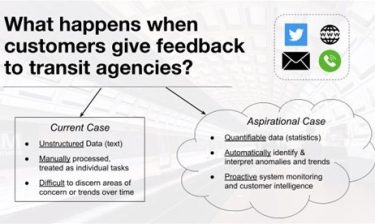Technology-enabled mobility: Five predictions for 2023
- Like
- Digg
- Del
- Tumblr
- VKontakte
- Buffer
- Love This
- Odnoklassniki
- Meneame
- Blogger
- Amazon
- Yahoo Mail
- Gmail
- AOL
- Newsvine
- HackerNews
- Evernote
- MySpace
- Mail.ru
- Viadeo
- Line
- Comments
- Yummly
- SMS
- Viber
- Telegram
- Subscribe
- Skype
- Facebook Messenger
- Kakao
- LiveJournal
- Yammer
- Edgar
- Fintel
- Mix
- Instapaper
- Copy Link
Posted: 8 June 2023 | Carol Schweiger - Schweiger Consulting | No comments yet
Carol Schweiger, Intelligent Transport Advisory Board Member and President of Schweiger Consulting LLC, shares her expertise and perspectives on the challenges and opportunities within the transportation industry as it embraces technology-enabled mobility, as well as the key factors driving its transformation.


By now you have read many articles about how technology-enabled mobility will change in 2023. The transportation industry is at a critical stage given the focus on climate change, equity, inclusion and the environment, and is attempting to address each of these. Unfortunately, there is no silver bullet to address all of these important issues that impact mobility and are impacted by transportation, but there are very promising innovations that I expect to see in the rest of 2023 and the beginning of 2024.
Evaluating MaaS innovations and re-defining its scope
First, Mobility-as-a-Service (MaaS) is at a crossroads. In 2022, we saw several MaaS technology vendors either close their doors or re-focus their business models to continue working in the industry. I recently conducted an extensive literature review for a MaaS research project and continue to be surprised at the sheer number of MaaS pilots that have been conducted since the concept was introduced in 2014 but have not been evaluated, or have not resulted in increased public transport ridership, decreased air pollution or increased mobility for travellers. Due to the lack of MaaS evaluations, we often do not know if the MaaS pilots’ goals and objectives were met.
However, at the same time that this re-structuring of the MaaS industry is happening, two other perceptions of MaaS are impacting mobility in the Asia-Pacific area: re-naming MaaS as either an Enhanced Journey Planner (EJP), an Enhanced Travel Information Service (ETIS) or Mobility-as-a-Feature (MaaF)1; and re-affirming and expanding MaaS in Japan. The former is based on work conducted by David Hensher, Chinh Ho and John Nelson at the Institute of Transport and Logistics Studies (ITLS) at the University of Sydney. They “suggest the term [MaaS] should be used more appropriately to describe a fully integrated and sustainable system, rather than just an enhanced travel planning app.”2
MaaS needs to show value in both sustainability and profitability to have buy-in from both government/society and business”
Realising that there are a myriad of definitions of MaaS and the fact that many systems that are being called MaaS do not reflect the original MaaS concept led these researchers to call for re-naming MaaS to what it typically is: either an EJP or ETIS. “MaaS needs to show value in both sustainability and profitability to have buy-in from both government/society and business. Without these two critical value propositions, and buy-in from critical stakeholders in the MaaS eco-system, MaaS will likely develop as a niche service, and techno/app developers can (and will) lead the debates which may not deliver real long-term value for society.”3
In the latter, at the same time, Japan has continued to encourage the development and implementation of MaaS. At the end of March 2023, the Ministry of Land, Infrastructure, Transportation and Tourism issued its most recent guidance document entitled ‘Guidelines for MaaS Linkage Version 3.0’. “In order to facilitate data collaboration within the MaaS in which each of the MaaS-related players participates, this guideline organises the items that should be noted when collaborating data from the standpoint of each player. This guideline is intended to provide a model example to promote collaboration among the players, and the players are not obliged to follow this guideline, but it is intended to facilitate the smooth provision and spread of MaaS, as well as to promote collaboration among MaaS.”4 Figure 1 shows a summary of what is covered in this guidance document. According to Azarel Chamorro, these guidelines “are not legally binding, but projects that wish to receive public funding are encouraged to follow them.”5


Figure 1 – Summary of guidelines for MaaS-related linkage version 3.0
Empowering mobility through national data strategies
New national data strategies are providing the critical frameworks needed for an open and secure data ecosystem within which mobility data can be used to inform travellers among other functions”
Secondly, new national data strategies are providing the critical frameworks needed for an open and secure data ecosystem within which mobility data can be used to inform travellers among other functions. Of particular note are the new transport data strategy issued by the UK’s Department for Transport (DfT) and European data spaces in Germany, the Netherlands and Finland. The DfT “strategy set[s] out how the department, by working with the transport sector, can improve the discoverability, quality and accessibility of transport data. It outlines where the department will make targeted interventions to support a healthy transport data ecosystem, such as delivering a transport data catalogue ‘Find Transport Data’ to make finding the data needed to innovate much easier. This is also part of the department’s efforts to improve the granularity, timeliness and coverage of data we collect and use.”6
The “EU Data Strategy7 announced the creation of common European data spaces in key sectors, including mobility. Data spaces bring together the governance and infrastructure to facilitate the pooling and sharing of data in a controlled and secure way.”8 Several European mobility data spaces have already been created: Mobility Data Space in Germany9; iSHARE10 in the Netherlands and other European countries; and MyData11 in Finland. Given the importance of data and data exchange in the technology-enabled mobility sector, there is no doubt that these kinds of initiatives will grow significantly in 2023 and 2024. Each of the existing data spaces is addressing what has been discussed as barriers in mobility, including lack of open data, consistent data standards and data governance. For example, the iSHARE data space’s framework is based on four pillars: data interoperability; data sovereignty and trust; data value creation; and data spaces governance.


Sustainable funding solutions for the public transport industry
In 2023 and 2024, agencies will be developing more long-term funding strategies, so that they are not dependent on one-time funding streams”
Thirdly, the ‘fiscal cliff’ is looming over the public transport industry, at least in the U.S. During the COVID-19 pandemic, additional federal funding was offered through the Coronavirus Aid, Relief, and Economic Security (CARES) Act. This act provided $25 billion to transit agencies primarily to keep transport agencies operating and cover the lack of revenue due to low ridership. The CARES Act funding will be exhausted in many agencies in 2023, which will jeopardise some technology initiatives, such as mobile fare payment systems.
While some new funding is being provided through the Bipartisan Infrastructure Law (as enacted in the Infrastructure Investment and Jobs Act [IIJA]), it is uncertain whether or not this new funding will support existing and new technology initiatives. Fortunately, the IIJA has funded numerous federal public transport technology initiatives, but once these projects are completed, agencies could experience another fiscal cliff. In 2023 and 2024, agencies will be developing more long-term funding strategies, so that they are not dependent on one-time funding streams.
Meeting the demands of a shifting commute landscape
Fourthly, the transportation planning community has recognised that new commute weekday trip patterns are a result of COVID-19. Now, many employees only commute to an office for work a few days a week, and then working at home for the rest of the work week. This change in trip patterns is causing many public transport agencies to review their schedules and offer more on-demand services, which is creating more demand for technology. This trend will continue into 2024, as agencies strive to best serve their existing riders and encourage non-riders to use public transport.
Harnessing artificial intelligence for enhanced operations
Finally, one of the most significant trends in 2023 is the further use of artificial intelligence (AI) in public transport. Here, I am not discussing Chat Generative Pre-Trained Transformer (ChatGPT), but rather the continuing development of transport technology that is aided by AI. A current example of the use of AI in public transport is the system that is installed on New York Metropolitan Transportation Authority (MTA) buses to conduct automated bus lane enforcement.
According to the Massachusetts Institute of Technology (MIT), AI can be used in several other functions to improve public transport, including the following12:
- Monitoring:
- Computer vision for transit travel time prediction
- Natural language models for transit customer feedback intelligence
- Control: Deep reinforcement learning for real-time bus control
- Ethics: Algorithmic fairness in travel demand prediction.
For example, Figure 2 shows what happens today when a customer provides feedback to a transit agency, and what is desired from that feedback. On the other hand, Figure 3 shows how unstructured data can be used to improve transit operations.


Figure 2 – Using AI to improve customer feedback13


Figure 3 – Using AI to improve transit operations14
These are my five predictions for technology-enabled mobility in the rest of 2023.
References
- David A. Hensher & Sampo Hietanen (2023) Mobility as a feature (MaaF): rethinking the focus of the second generation of mobility as a service (MaaS), Transport Reviews, 43:3, 325-329, DOI: 10.1080/01441647.2022.2159122.
- The University of Sydney Business School, “Stop calling it Mobility as a Service (MaaS): It actually is an Enhanced Journey Planner (EJP) or an Enhanced Travel Information Service (ETIS),” 7 March 2022, https://www.sydney.edu.au/business/news-and-events/news/2022/03/07/stop-calling-it-mobility-as-a-service–maas—it-actually-is-an-.html#_ftn1.
- Ibid
- Translated into English by DeepL: Policy Bureau, Ministry of Land, Infrastructure, Transport and Tourism, “Linkage of MaaS-related data guideline Ver. 3.0,” Revised on March 31, 2023, https://www.diigo.com/item/pdf/csd/504e.
- Azarel Chamorro, LinkedIn post, April 10, 2023, https://www.linkedin.com/feed/update/urn:li:activity:7051040307831848960/.
- Department for Transport, “Transport Data Strategy: Innovation Through Data,” © Crown copyright 2023, page 3, https://assets.publishing.service.gov.uk/government/uploads/system/uploads/attachment_data/file/1136478/dft-transport-data-strategy.pdf.
- “The European data strategy aims to make the EU a leader in a data-driven society. Creating a single market for data will allow it to flow freely within the EU and across sectors for the benefit of businesses, researchers and public administrations.” https://commission.europa.eu/strategy-and-policy/priorities-2019-2024/europe-fit-digital-age/european-data-strategy_en.
- https://digital-strategy.ec.europa.eu/en/policies/mobility-data
- https://mobility-dataspace.eu/
- https://ishare.eu/
- https://www.mydata.org/
- Webinar held on May 5, 2023, “A.I. in Public Transit,” presentations led by Professor Jinhua Zhao, https://www.mmi.mit.edu/forum.
- Michael Leong, “Natural Language Models for Customer Feedback Intelligence,” presentation during May 5, 2023 webinar entitled “A.I. in Public Transit,” https://www.mmi.mit.edu/forum.
- Ibid


Related topics
Accessibility, Artificial Intelligence, Mobility Services, Passenger Experience, Public Transport, Sustainable Urban Transport
Related modes
Bus & Coach
Related countries
Finland, Germany, The Netherlands, United Kingdom, United States
Related organisations
Department for Transport (DfT), Metropolitan Transportation Authority (MTA), Ministry of Land Infrastructure Transport and Tourism
Related people
Azarel Chamorro, Carol Schweiger, Chinh Ho, David Hensher, John Nelson








